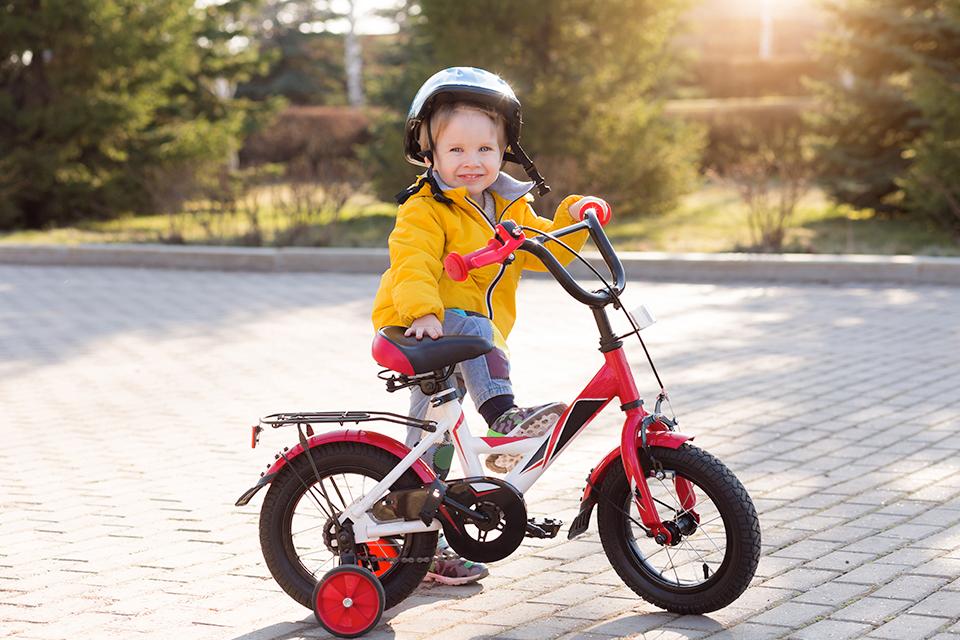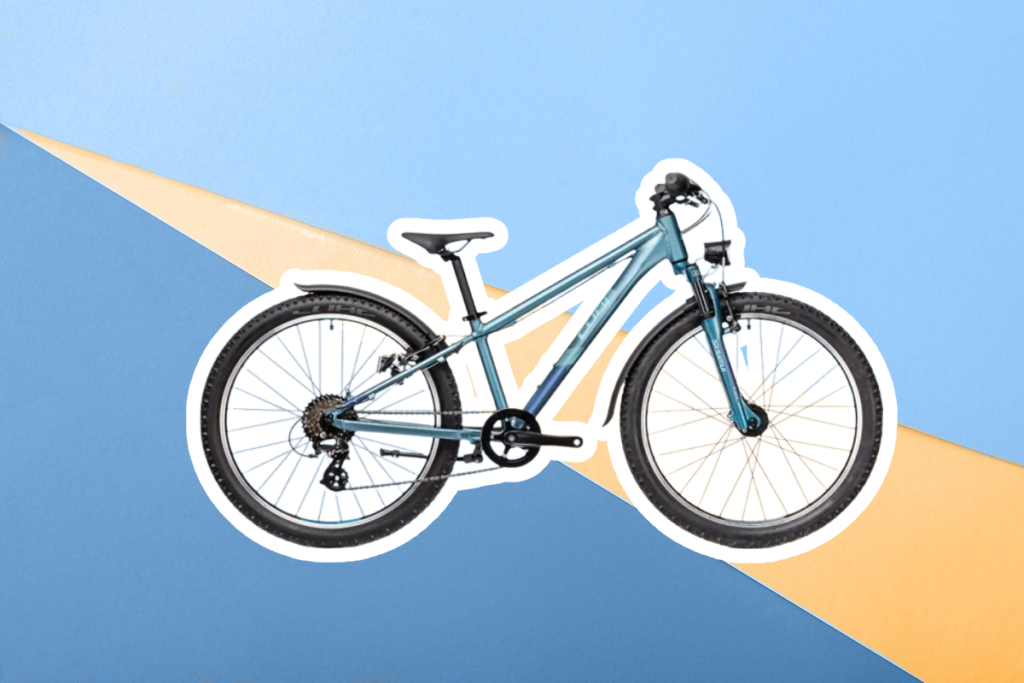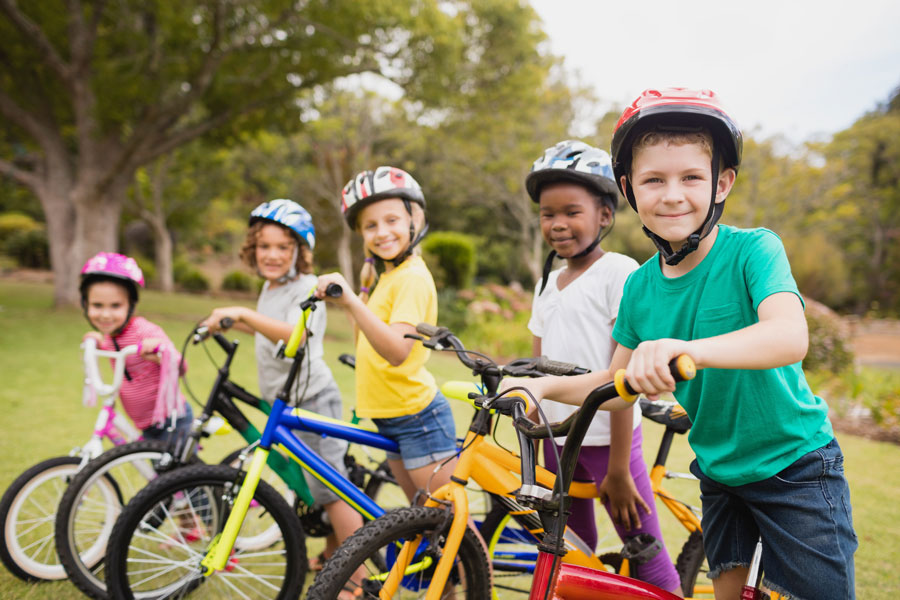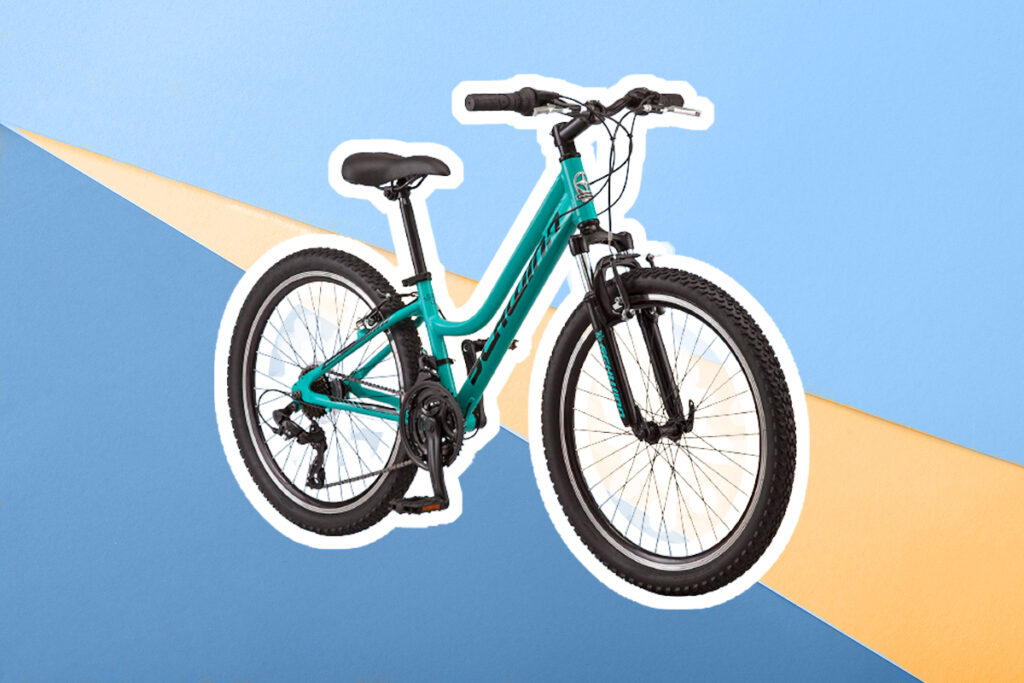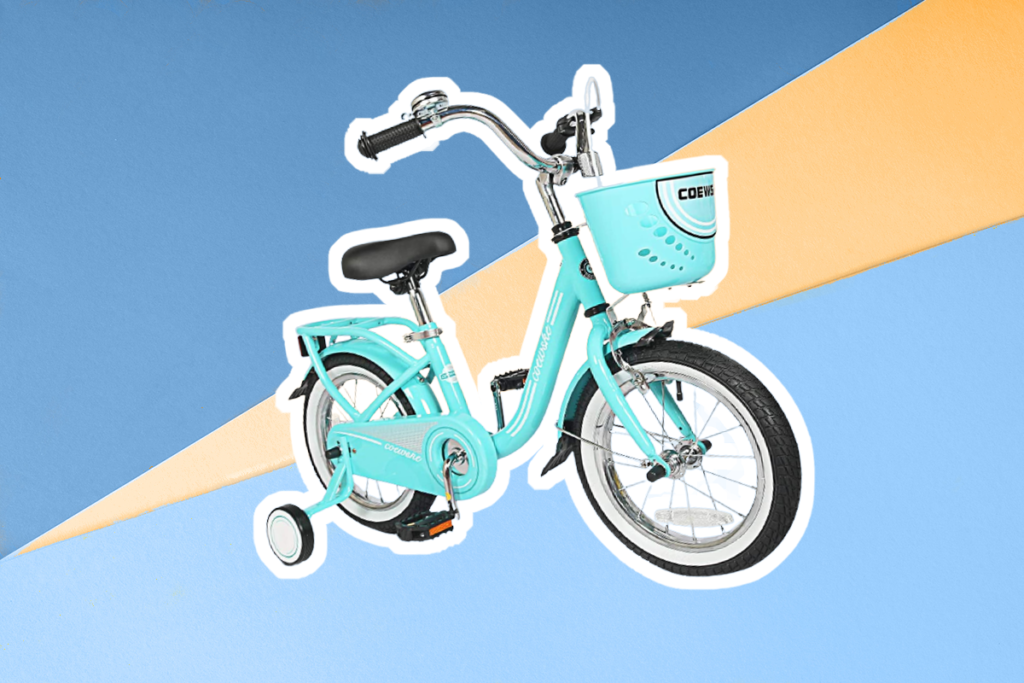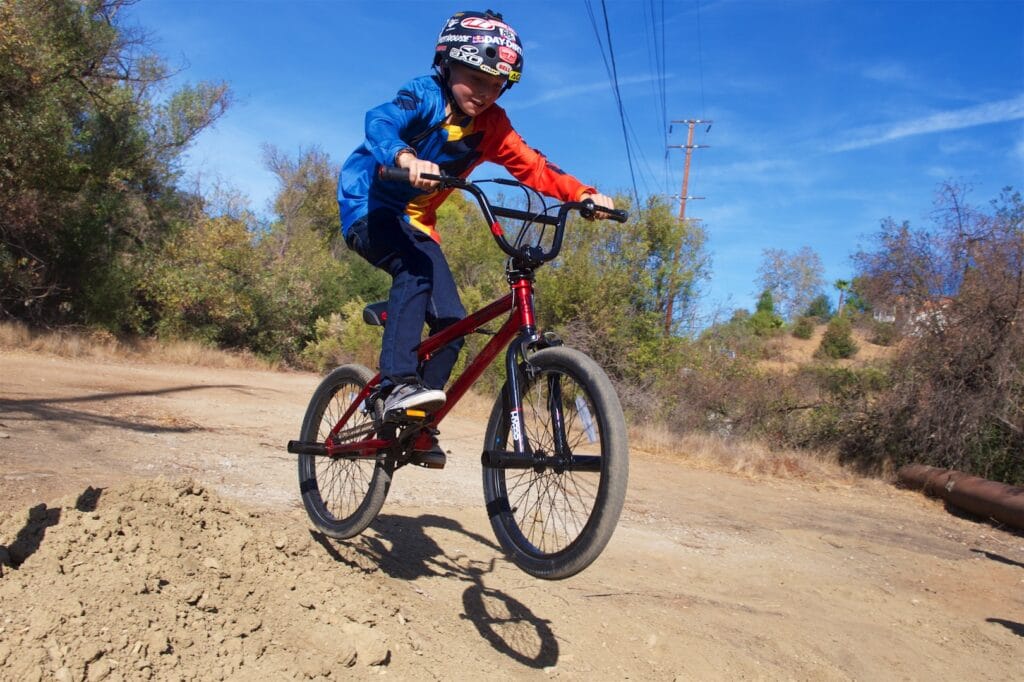- Trails
-
Bikes
-
Gear
-
Tips & Tricks
-
About us


Nothing comes close to that feeling of freedom and accomplishment you get when you coast on 2 wheels for the first time. It is one of the best early life wins and the reason why instructors, teachers, parents, and the cool kid next door are considered heroes for teaching you how to ride a bike. Now it’s your turn to be the hero, and you are wondering how to teach a kid to ride a bike.
This article has all the pro tips on how to teach a kid to ride a bike, whether they are new or getting off training wheels. There is a stress-free and straightforward way of teaching a child how to ride without using training wheels, even if they are struggling to transition from a balance bike to a pedal bike. Some kids need help with the entire process, while some just need to understand how to pedal forward. Read on to find out how you can help your child ride a bike.
Before you begin the lessons, you have to ensure you have the right bike fit and safety gear for your child’s safety. Ensure the child wears a bike helmet Trusted Source Kids and Bicycle Safety Bicycle riding is fun, healthy, and a great way to be independent. But it is important to remember that a bicycle is not a toy; it’s a vehicle! Be cool – follow some basic safety tips when you ride. one.nhtsa.gov even if they are riding just down the street. Get a helmet that fits perfectly and help the child wear it properly to protect their head from injuries. Besides a helmet, you can also get other protective gear like gloves, elbow and shin guards, knee pads, and closed shoes.
Here is a step-by-step guide on how to get the right bike helmet fit for your child;
Step 1
For starters, the helmet should sit level across the kid’s forehead, and it should not be more than 1 inch above the eyebrows. If you find that the helmet moves more than 1 inch when you push it side to side, or it sits high on the forehead, try a different size.
Step 2
Adjust the helmet’s side straps to form a ‘V .’The straps should rest under each ear.
Step 3
Buckle the chin strap and ensure it is snug. It should not rock back and forth on the child’s head. You will know it is snug if you can only slip one or two fingers between the strap and the child’s chin.
According to popular reviews, the KUYOU kids’ protective gear is one of the best affordable and high-quality safety gear you can get for your child. It comes with an adjustable child helmet that can fit kids between the ages of 3 and 8, a wrist guard, elbow pads, and knee pads.
After getting the right safety gear for your kid, you have to prepare them for the bike ride. The best way to teach a child how to ride a bike is to let them balance on 2 wheels first before pedaling. Kids who start off on a balance bike have an easier time learning how to ride a bike compared to those who start on training wheels. You can get your child a balance bike to teach them balance first. Here are some things you should do to prepare your child for their first bike ride.
Finding your child a bike that fits is crucial. Most parents/guardians make the mistake of buying a bigger bike so that their child can grow with it. A bigger bike will be harder to control. Also, when learning to ride a bike, kids’ biggest fear is usually falling. With the right bike fit, they’d be able to step down when they need to, and this eases the fear concerns.
Ensure that your child can stand over the top tube with both of their feet planted on the ground. Also, be extra keen on the reach, which is the distance between the bike’s seat and handlebars. The kid should be able to reach the handlebar and the hand brakes easily without bending too far.
Do you need to find a road bike under 500 dollars for your kid and wonder what to consider when buying?
If you are in the market for a child’s bike, consider the popular Schwinn hybrid BMX bike. It is specially designed for kids as it features a rear coaster brake and a front caliper brake which make the transition to a hand-brake-only bike easier when they are ready.
You can teach your kid how to balance first before they learn how to pedal. Balance learning is the quickest way to learn how to ride a bike. If your child’s bike is not a balance bike, you can easily modify it to a standard bike so they can learn to balance on it. Are you looking for a balance bike and have no idea where to get one?
Training wheels are added to kids’ bikes to help them get used to sitting on a bike and using their legs to pedal. They don’t help in learning balance. You can remove the training wheels to modify the bike into a standard bike that can help your kid learn to balance.
You can also remove the bike’s pedals and lower the seat to make your child feel comfortable and steady before they start learning balance. You can use a pedal wrench to remove the pedals.
Ensure your child’s bike tires are properly inflated to allow them to roll smoothly and have an easier time coasting. The correct tire pressures are printed on the tire’s sidewalls.
If you don’t make it fun enough, the child will not look forward to your bike riding sessions. Cheer them up when they try to maintain balance on the bike or offer some fun, enticing incentives when they balance on the bike for long.
Before you start teaching your child how to ride a bike, choose a safe space that will make them feel comfortable. For a start, avoid public trails and sidewalks to avoid confusion from pedestrians and other vehicles. Lonely trails, empty parking lots, and the park are the most ideal places. If your child has to learn to ride in a busy area, ensure they do so under strict supervision.
Your child should never learn to ride a bike on the road. Road bike safety is another lesson on its own. A young rider isn’t street savvy enough to share the road safely with other users. Generally, a child under the age of 10 is yet to develop spatial awareness to ride safely on the road alongside other bikes and cars.
Also, many people make the mistake of training their children to ride a bike on grass. Grass appeals to most people as a soft landing for when the child falls when they lose balance but it makes the bike harder to propel. Moreover, it poses the risk of unforeseen obstacles which can be more dangerous. Flat surfaces are the most ideal. All you have to do to guarantee your child’s safety is invest in proper safety gear.
When your child becomes a confident rider, you can allow them to ride on cycle paths and roads that are safe for teens and adults. You will know your child is ready to hit the rid when they grow onto a 20, 24, or 26-inch bike.
Here is a simple way of teaching your child how to ride a bike;
The first step in starting your child’s bike riding lesson is to practice getting on and off the bike. Although it is an overlooked step, some kids need to get on and off the bike severally to get comfortable. You can lean the bike on one side toward them the make the practice easier.
Once they learn how to get on and off the bike, you can teach the kid how to scoot and glide. Let the child sit on a pedal-less like and hold the handlebars then walk around the practice area while seated on the bike. There are two ways of scooting you can have them try;
Moonwalk or bouncy house: This is pretty much like walking in a bouncy house. Instead of shuffling their feet, encourage the child to take long steps, one foot at a time.
Hops: let the kid push off with 2 feet simultaneously.
As the child practices scooting and coasting, encourage them to always look forward and never their feet. Looking up helps the child maintain an upright posture. You can do this by walking in front of the child and holding out different numbers of fingers so they can shout it out as they scoot toward you.
Once the kid is a pro at scooting, challenge them to pick up their feet and glide. Let them increase the distance between their feet and the ground gradually. You can demonstrate how to glide on your bike. Show them how to glide with legs outstretched as counterbalances. Keep reminding the child to remain seated as they can’t glide if they are not seated.
Here are fun ways of gliding that your child can enjoy;
Hot lava: Draw a set of lines at least 10 feet apart on the practice area with sidewalk chalk. Draw flames of hot lava in between the lines, then tell the kid to get some speed going. They should pick up their feet when they glide over the ‘hot lava’ area. You can extend the ‘hot lava’ area farther as they progress to improve their balance.
Timed glide: count up to 10 for your child to glide up their feet for 10 seconds. You can add more time as they gain confidence to see how far they can go with their legs off the ground.
Once the kid has learned how to scoot and glide and you see that they are enjoying everything, introduce steering and turning. You can begin with big, easy, looping turns. Here are some fun games you can try to practice steering and gliding;
Easy obstacle course: Set up some orange safety cones in a pattern then tell the child to try steering between them.
Follow the leader: Get on your bike then tell your child to follow you. Go easy and slow, but make big turns every time. If you are a mum in need of a bike, check out these gravel bikes for women.
Before the kid starts pedaling, you have to show them how to use the brakes. The child needs to know how much pressure it takes for the brakes to work. If the bike has coaster brakes, hold it, and while on it, let the child practice pressing on the brakes until they can comfortably use them without wobbling.
If the bike has handbrakes, let the child practice using them by walking alongside the bike while holding them with a couple of brakes. Let them slow down the bike using the hand brakes.
You can introduce pedaling once the kid is able to coast on the bike with their feet up, as well as look ahead and take turns while coasting. You can return the pedals on the bike, but just leave the seat in the lower position so that your child can put both their feet on the ground to stop.
The first step in pedaling is letting your child get used to picking up their feet and finding the pedals. Stand in front of the child seated on the bike, then hold the handlebars and have them practice picking up their feet and placing them on the pedals. They should look at you and not their feet to maintain balance.
You can get the child to look ahead by telling them to focus on their helmet. Tell them to put their legs on the pedals while looking ahead when you say a certain word like ‘hot lava.’ Assure them that you will hold them so they worry less about falling.
Once the child learns how to use the brakes, you can go ahead and teach them how to move from a stopped position with pedals. There are a couple of ways of doing this as long as the bike is in easier gear. Also, ensure the child feels balanced when seated on the bike before they are ready to go.
Let the child sit on the bike with one foot flat on the ground and the other on a pedal raised to the 1 to 2 o’clock position. Ensure the pedal is not too level as they won’t have enough momentum. Train your child to press down hard on the front pedal to give the bike its forward momentum.
Alternatively, you can let the child start on the down position with one foot on a pedal and the other scooting. Let them take a scooter step to get the speed going, and then find the second pedal. They can use either the long stride scoot technique or the hop, with one foot at a time or both.
When the child starts to pedal, don’t hold their bike. Give them a chance to balance on the bike themselves until they feel confident enough to ride on their own. You can only hold the bike for a short stretch if the child has trouble getting the feel of it. If you find that the child is not balancing well and you have to hold the bike for long stretches, then you need to go back to learning balancing before you go on with this step.
You can make pedaling and braking fun with the following games;
Place a safety cone about 20 feet ahead of your child’s riding path and have them stop before hitting it.
Another option is to play ‘Red light, Green light’ by varying the distances and encouraging even faster stops.
As your child gets the hang of pedaling a bike, they can start practicing turns. Have the child begin with large, wide circles and figure 8s. They can make wide turns first and then advance to smaller turns. Also, turning one side might be easier for them than the other.
You can make steering and turning Trusted Source Kids Races To register your child, please select the KIDS RACE REGISTRATION button below, and complete the form. cyclingclassic.org fun with a few games like setting up a line of cones or other friendly objects for your child to navigate. Start with a simple pattern for the child to master turning before you advance to sophisticated patterns.
Here are some top tips for teaching kids of different ages to ride a bike.
Training kids over the age of 3 to ride a bike depends on whether they are new to a bike, or getting off training wheels. For example, teaching a 10-year-old to ride a bike requires a different approach. Here are a few suitable tips to help in both situations;
Now, that you know the easiest way to teach a kid to ride a bike, you can start practicing. It is a rite of passage that everyone ought to experience. With all the tips and pointers we have provided on how to teach a kid to ride a bike, it should be a breeze for you, whether the child is totally new to a bike or is transitioning from training wheels. Kids can be a challenge to work with, but if you make the process fun, they will enjoy it, and their desire to learn will increase.
The last thing you want to do is become a drill sergeant as it will put off the child and make them uncomfortable. Don’t pressure the child to become a pro quickly. Let them enjoy each stage of learning. You can even use games and rewards to make it more fun.
